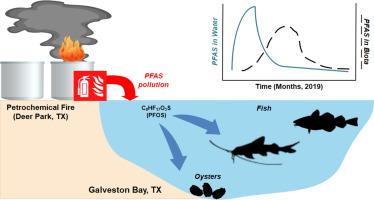Science of the Total Environment ( IF 8.2 ) Pub Date : 2021-09-16 , DOI: 10.1016/j.scitotenv.2021.150361 Rayna M Nolen 1 , Patricia Faulkner 1 , Ashley D Ross 2 , Karl Kaiser 2 , Antonietta Quigg 3 , David Hala 4

|
The use of aqueous film forming foams (AFFFs) as fire retardants is an critical point-source for per- and polyfluoroalkyl substances (PFASs) pollution into the aquatic environment. This study investigated PFASs pollution in the surface waters and biota (shellfish and fish) of Galveston Bay, following AFFFs use to extinguish a petrochemical fire (March 17th to 20th, 2019) of oil storage tanks at the International Terminals Company (ITC) in Deer Park (Houston, TX). The levels of up to twelve EPA priority PFASs were measured in surface waters and biota from March–November 2019. PFASs levels in surface waters showed mean total levels in March and April 2019 to be from 4× to ~300× higher than those measured in the following months. PFOS (perfluorooctanesulfonic acid) was the most abundant homolog measured at ≥66% of total PFASs. Maximal PFOS levels exceeded the State of Texas' water regulatory limit of 0.6 μg L−1 in 3% of the samples analyzed in March and April 2019. PFOS was also the most prominent homolog (≥66% of total PFASs) measured in eastern oysters (Crassostrea virginica), red drum (Sciaenops ocellatus), gafftopsail catfish (Bagre marinus), and spotted seatrout (Cynoscion nebulosus). A statistically significant elevation of PFOS body-burdens was measured in oysters and spotted seatrout in April and May 2019, respectively. A Hazard Ratio calculation for seafood safety suggests an advisory of 1–2 meals per week for gafftopsail catfish and red drum, and 2 meals per week for spotted seatrout to be protective for human exposure to PFOS. The levels in oysters indicated no immediate concerns for the dietary exposure of humans. Our results highlight a need for continual monitoring to assess the long-term fate and seafood advisories for PFASs.
中文翻译:

德克萨斯州休斯顿鹿园(2019 年 3 月 17 日至 20 日)在 ITC 火灾期间使用 AFFF 后,加尔维斯顿湾地表水和生物群(贝类和鱼类)中的 PFAS 污染
使用水性成膜泡沫 (AFFF) 作为阻燃剂是全氟和多氟烷基物质 (PFAS) 污染水生环境的关键点源。本研究调查了加尔维斯顿湾地表水和生物群(贝类和鱼类)中的 PFAS 污染,此前 AFFF 用于扑灭鹿的国际码头公司 (ITC) 储油罐的石化火灾(2019 年 3 月 17 日至 20 日)公园(德克萨斯州休斯顿)。从 2019 年 3 月至 11 月,在地表水和生物群中测量了多达 12 种 EPA 优先级 PFAS 的水平。地表水中的 PFAS 水平显示,3 月和 2019 年 4 月的平均总水平比在接下来的几个月。PFOS(全氟辛烷磺酸)是最丰富的同系物,占总 PFAS 的 66% 以上。-1在样品的3%三四月2019 PFOS分析也是在东部牡蛎(测得的最突出的同系物(总PFASs的≥66%)牡蛎锦葵),红色鼓(美国红鱼),海鲿(巴格雷marinus ) 和斑点 Seatrout ( Cynoscion nebulosus)。分别于 2019 年 4 月和 5 月在牡蛎和斑点海鳟中测量到 PFOS 身体负荷的显着升高。一项针对海鲜安全的危害比计算表明,建议对鲶鱼和红鼓鱼每周吃 1-2 餐,对斑点鲇鱼每周吃 2 餐,以防止人类接触全氟辛烷磺酸。牡蛎中的含量表明人类的饮食暴露没有直接的担忧。我们的结果强调需要持续监测以评估 PFAS 的长期归宿和海产品建议。











































 京公网安备 11010802027423号
京公网安备 11010802027423号